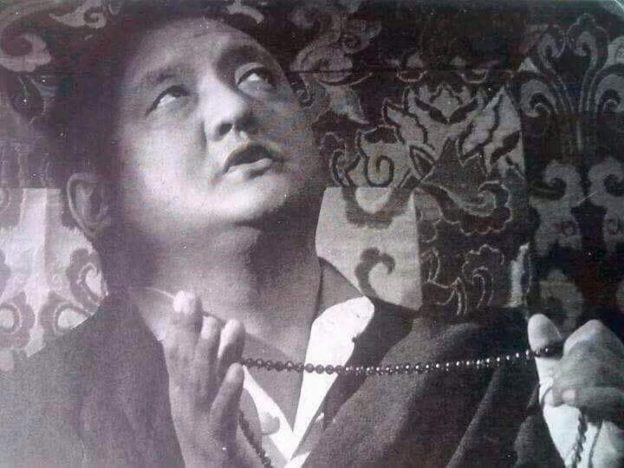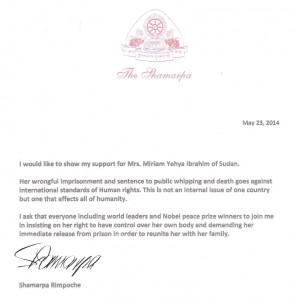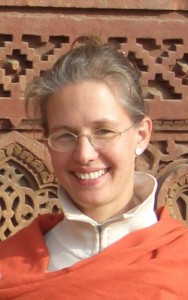Q: Rinpoche, why did you choose to give the lineage transmissions to His Holiness Karmapa Thaye Dorje, but when it was time for His Holiness to receive the monastic vows you appointed Khenchen Rinpoche Trinley Paljor and a group of monks from Shar Minub Monastery in Nepal to give them instead? As I understand it, you received your monastic vows from His Holiness the late 16th Karmapa when you came to the age of 20. Why didn’t you bestow these vows to His Holiness Karmapa Thaye Dorje yourself?
SR: Well first, just to clarify, I have never given monastic vows to anyone, not only Karmapa. I feel that when someone wants to take monastic vows, they should receive them from a group of monks who hold the full vows, and who have at least purely held the first set of 4 and the second set of 13 vows. This is why I organized a temple, called Nera Jana, with 20 rooms for fully-ordained monks, led by the V.V. Khenchen Thrinly Paljor Rinpoche in Kathmandu. So far only eight fully-ordained monks have committed themselves to protecting the lineage of the great Vinaya, but they are the most pure monks in the world these days.
So one reason for not giving the vows was due to my generally being a little pessimistic about the Tibetan monastic system, which is why I organized Nera Jana and the Shar Minub monastery (http://www.bodhipath.org/sharminub/). But another reason was because of very particular circumstances that happened to me many years before.
Q: Which circumstances were these?
When I came to the age of 29, I had to handle the responsibility of monastery construction in Nepal and India. In those times, Tibetan refugee Lamas could not raise enough money from the local people in Nepal and India. Therefore, they had to get the financing from foreign countries.
But back then, it was not possible to open accounts in India that were allowed to receive foreign funds. There was a way of getting foreign funding, but this involved avoiding the tax collectors from the government, which required breaking a monastic vow. There was no other choice but to do that back then. Many of the other lamas did this and didn’t care about breaking these vows since it was invisible. But, I did care and I still do.
In order for the monastic vows to be considered broken, one must break one of the four main vows given to monks, and avoiding tax collectors is related to one of them. Therefore, I could not ignore this. I did not want to break the vows.
According to the Vinaya, if you feel your vows are in danger you can give them back to monks who are presently keeping these vows. If you give back the monastic vows, you cannot break them and you can receive them again later if you wish.
So at that time, I invited four monks – Khenpo Chodrak, Lama Dawa, Lama Gyurme and Lama Thenpa – to perform this ceremony in front of a statue of the Buddha. There is a special text written by the 15th Karmapa explaining how to return your vows. I followed the instructions given in that text. Then, I took the ‘semi-genyen’ vows.
Q: When was this?
SR: It was in 1982.
Q: What are these four major precepts of the monastic vows that you mentioned earlier?
SR: Abstaining from sexual activity is one. Not killing a human (either directly or indirectly) is another. Refraining from stealing the property of others, is a third. This vow includes avoiding tax collectors of the government (or any tax for that matter). Lastly, there is a vow promising not to deceive devotees by acting as a holy teacher.
Among these four, all of them – except the vow for abstaining from sexual activity – have the nature of bad karma in addition to breaking vows. As far as the vow for abstaining from sexual activity, as long as it is not sexual misconduct it does not have the nature of bad karma, but only the karma of breaking a vow. But if you are involved in sexual misconduct, then you will have the result of bad karma as well as breaking vows.
Q: If sexual relations with the opposite sex does not have the nature of bad karma, then why is it a major monastic vow?
SR: Well, the Vinaya is mainly for Theravadayana practitioners. The main goal of theTheravadayana practice is to abandon the cause of rebirth into Samsara. Therefore, Theravada-yana practitioners are mainly aiming to cut these causes of rebirth, and normal sexual relations with the opposite sex is the direct cause of rebirth in Samsara. Whether it is a good rebirth or not depends on other karmas (good or bad) and accumulated merit.
For instance, the mother of Asanga and Vasubandhu gave up her monastic vows. She then made the wish to have two great sons who could revive the Mahayana and Theravadayana. Therefore, in the Bodhisattvayana, bodhisattvas use the karma of natural sex in order to be reborn in the realms of living beings. Nevertheless, this doesn’t mean that you can go totally crazy and indulge in sexual promiscuity.
In the Vajrayana, once you have become a highly qualified Vajrayana practitioner – like Tilopa or Naropa – then being in union with a qualified female practitioner in special retreat conditions is actually the key practice for enlightenment. Therefore, this is one of the main reasons why the Theravada tradition does not accept the Mahayana and Vajrayana as genuine Buddhist paths. They also tend to regard Vajrayana practices as being Hindu in nature.
Q: You mentioned earlier that you took the semi-genyen vows in 1982. What were those precepts? What does semi-genyen mean?
SR: I took the genyen vows for abstaining from sexual misconduct. I also took the vow for not killing humans and I took the vow to not deceive devotees by acting as a holy teacher. But I did not take the vow for stealing because this vow falls in the category of avoiding tax collectors, which was potentially a problem due to my responsibility at that time of financing the construction of the monasteries.
Q: Does avoiding tax collectors have the nature of bad karma as well as the karma of breaking monastic vows?
SR: Well, in the Vinaya, the mention of avoiding tax collectors is mainly there to prevent the monks’ involvement in illegal activity so that they don’t receive punishment from the government. However, one has to check logically whether it brings bad karma or not.
So if we begin to analyze, then of course there would be bad karma if this tax were for the common good of others, such as a tax which funds a hospital for the blind or a tax that will build a road. This would have bad karma. But in general, I think it does not necessarily have the nature of bad karma.
I think it is similar to the earlier example of having natural sex, but without engaging in sexual misconduct. It is not naturally bad karma by itself, but it will still be breaking the monastic vows. And this, for many reasons, will still have the effect of disturbing the meditation practice.
Q: You mentioned a pessimism towards the Tibetan monastic system earlier. Could you explain more about what you meant by that?
SR: I just mean that the Tibetan monastic system is very ceremonial. Therefore, the Vinaya discipline is not at all convenient to practice in such an environment.
One example is that the Tibetan monastic system has high lamas whose ranks are shown by the height of their thrones. In the Vinaya that is the situation that the Buddha mentioned not to have for monks. Why? Because then you will become proud – due to the ego – which is one of the biggest disturbances to your dharma practice. Therefore, the Buddha decided that monks were not allowed to sit on any chair higher than the length of their own arm, from elbow to fingertips.
Secondly, according to the Vinaya, you must not touch gold or money. However, in monasteries the high lamas often have stands made of gold for their tea cups and so forth.
Also, according to the monastic vows you can only wear robes that are made of the cheapest cloth, in order not to become attached to your clothing. You also cannot have more than three sets of these robes. However, in Tibetan monasteries, they are obligated to wear clothes sewn from finely made golden brocade.
These are just examples. To be honest, there are many things that are done in the Tibetan monastic system that go totally against the Vinaya. Yet, you are required to take these vows. Therefore, when you take the vows, already a few hours afterward you begin breaking them, and continue doing so until you die. So why take these vows if you cannot follow them?
I feel that the monastic vows are really not at all convenient for people unless they have totally renounced their worldly life and do nothing other than meditate. Therefore, some years back, I organized a temple called Nera Jana, part of the Shar Minub monastery near Kathmandu, for meditators who are truly able to renounce their worldly lives. They are the only ones who can receive the full monastic vows.
The rest live as a semi-monastic community. In Tibetan it is called tsang chod genyen. This means they cannot have a wife or engage in any sexual misconduct. They also have vows against stealing, intoxicants, and killing, as well as deceiving devotees. These practitioners are part of the so-called community of dratsang, a community who follows certain precepts in order to be free from worldly distractions.
There is also another class of practitioners, who are called yong dzog genyen in Tibetan. They have taken the vow of refraining from sexual misconduct but they can have a spouse. The other four vows they follow are the same. However, they cannot stay in the monks’ or nuns’ communities or wear the special yellow robe.
Also, any tulku, while they are in Shedra for study, has to behave exactly the same as the other students and follow the students’ rules. However, if a tulku was recognized by a spiritual leader while he was still young, then, according to the Mahayana, as long as they are not breaking the bodhisattva vows, he or she belongs to the advanced bodhisattva community. Therefore, in order to be identified as a spiritual master of sentient beings, even if he or she is a family holder, they can wear the lama robes but not the yellow shawls. If they are not family holders, then even if they are not tsang chod genyen they can still wear a yellow robe but not the type reserved for fully-ordained monastics.
However, if anyone was appointed as a tulku by themselves or by their family, then they are not recognized as a genuine tulku and are bound by the rules of any other student.



